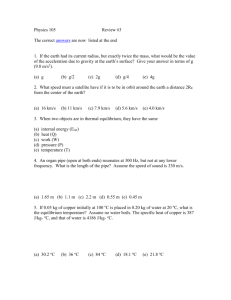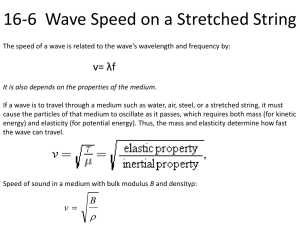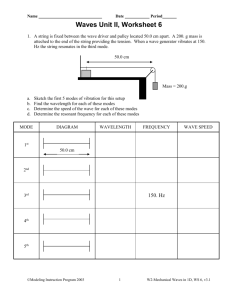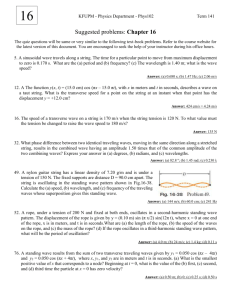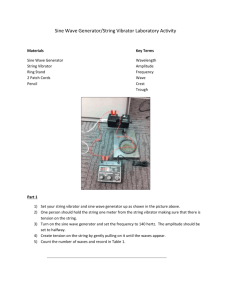Chapter 15 Week 15. Mechanical Waves
advertisement
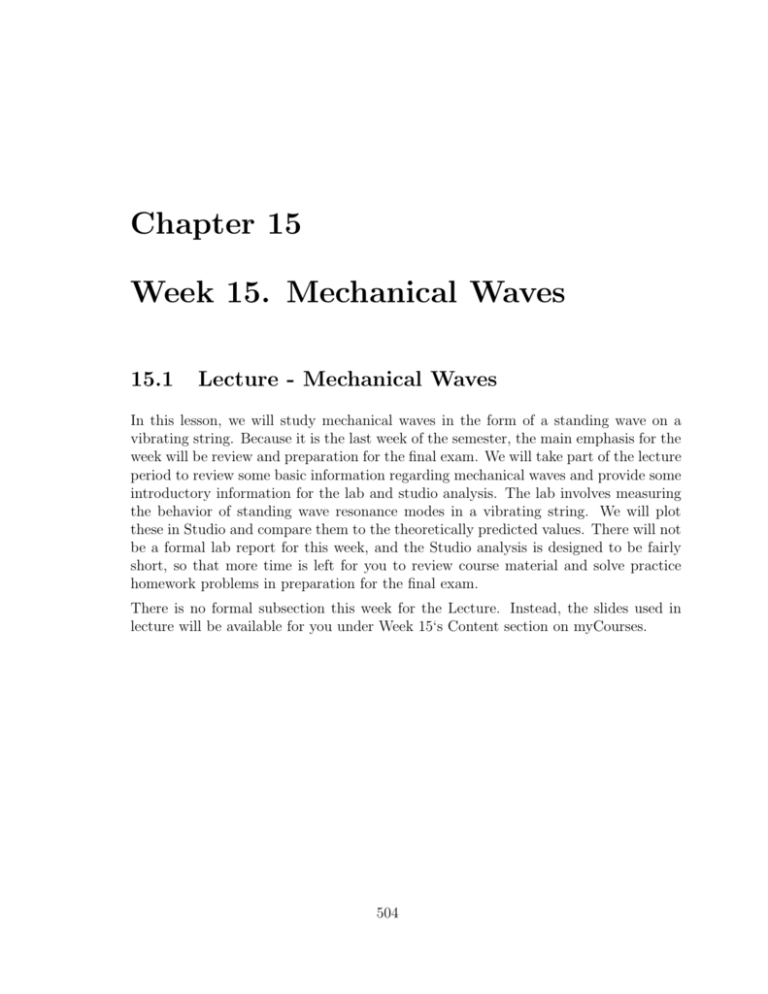
Chapter 15 Week 15. Mechanical Waves 15.1 Lecture - Mechanical Waves In this lesson, we will study mechanical waves in the form of a standing wave on a vibrating string. Because it is the last week of the semester, the main emphasis for the week will be review and preparation for the final exam. We will take part of the lecture period to review some basic information regarding mechanical waves and provide some introductory information for the lab and studio analysis. The lab involves measuring the behavior of standing wave resonance modes in a vibrating string. We will plot these in Studio and compare them to the theoretically predicted values. There will not be a formal lab report for this week, and the Studio analysis is designed to be fairly short, so that more time is left for you to review course material and solve practice homework problems in preparation for the final exam. There is no formal subsection this week for the Lecture. Instead, the slides used in lecture will be available for you under Week 15‘s Content section on myCourses. 504 15.2 Lab - Standing Waves - Vibrating String 15.2.1 Scope This week in lab we will use a sine wave signal generator to power and control a mechanical wave driver, which is essentially a re-purposed stereo speaker. The wave driver in turn excites sinusoidal vibrations in an elastic string, which is held under tension by suspending the string over a pulley and suspending a dead weigth to the end of it. 15.2.2 Goal The goals of this laboratory experiment are to (a) generate various resonant modes on a string using a wave generator/speaker driver system, and (b) begin to understand the physics of mechanical waves. 15.2.3 Reference Documents The following documents may be helpful. • Video demonstrating the operation of the experiment. 15.2.4 Terminology The following terms must be fully understood in order to achieve the educational objectives of this laboratory experiment. Amplitude Wavelength Resonance 15.2.5 Velocity Node Tension Frequency Antinode Linear Density Summary of Test Method A video related to your lab experiment is available for viewing on myCourses. The video provides you with an understanding of what you need to do during the lab. Please review the video before reading on, since it will provide you a good overview of the experiment and allow you to better understand the following information. 505 15.2.6 Calibration and Standardization The sine wave signal generator provided by the vendor sends a sine wave with a specified frequency to the speaker driver. We will treat the signal generator as a primary instrument and thus will not calibrate it. 15.2.7 Apparatus The experimental apparatus is illustrated in Figure 15.1. Figure 15.1: Apparatus for vibrating string standing wave experiment. 15.2.8 Sampling, Test Specimens The test protocol for this investigation involves three di↵erent parameters that can be varied during testing: • the mass applied to the string (and therefore the accompanying tension in the string), • the length of the string between the end supports (the post attached to the speaker assembly and the pulley), • and the driving frequency from the sine wave generator. The driving frequency is meant to be varied for every given test scenario over a range that captures the first 8-10 harmonics of the standing waves. Therefore, the tension 506 and the string length are the remaining parameters that can be used to distinguish individual tests. In your group, choose a string length at the beginning of the investigation and keep it the same throughout. Then, each group member should pick a di↵erent string tension (mass) for his/her own data collection. Follow the instructions in the lab video regarding the maximum and/or minimum values of mass to use, but otherwise try to spread out the test cases as much as possible. 15.2.9 Preparation of Apparatus Each lab group will need one complete lab apparatus. The Experiment Manager should sign out a key to the lab station cabinet from the lab instructor, and obtain any other additional equipment from the instructor as appropriate. For this investigation, the additional equipment includes a sine wave generator, wave driver (speaker assembly), and a power supply module. The Experiment Manager should create a table similar to that shown in Table 15.1, and present it to the instructor in order to get the key for the cabinet. The Experiment Manager should identify the various unique items employed during the experiment in the remaining rows of the table, adding rows as appropriate. At the end of the Lab, the Manager should verify with the instructor that all items have been returned to the locked cabinet, and both should sign-in the key and equipment in acknowledgement. Table 15.1: Lab Station Number Equipment Log for “Vibrating string experiment” Action Manager Signature Instructor Signature Date, Time Equipment Sign-out Equipment Sign-in Equipment Item Manufacturer Speaker Driver Sine Wave Generator Power Supply Module Deadweights (1 set) Ruler Tape Measure Sensor Bracket Pulley Assembly .. . Model S/N (If Avail.) The Lead Technologist and Assistant Technologist should assemble the apparatus with the dead weight suspended from a string suspended over the pulley. Confirm that the string is level with the table surface by adjusting the pulley height. Please be careful 507 with the sine wave generator and speaker drive assemblies as these are fairly delicate instruments. Exercise appropriate laboratory safety procedures. 15.2.10 Procedure - Lab Portion Record all observations and notes about your lab experiment in your logbook. Determine String Length Experimentally determine the distance from the end of the top of the pulley to the point where the string is connected to the rod next to the speaker. This is the string length L. Use good experimental techniques to record this length and its uncertainty. Measure the Mass of the Dead Weight Measure the mass of your weight m and record the uncertainty. Each team member will choose a unique mass to provide tension for the elastic string. Operate the System Follow the test method outlined in the appropriate video. For each member, the summary of the process to follow is: Start at low frequency and increase it slowly until the first resonance (fundamental mode)of the string is observed. This will have a single anti-node. Record the frequency in your logbook. Then proceed to the next mode, where two anti-nodes will be observed. It is a good idea to go slightly past this frequency and then return to slightly below while observing the standing wave pattern to obtain as accurate a measurement as possible. Repeat this procedure to measure the first 10 modes of the standing wave. Also, make notes of any other observations such as the nominal amplitude used with the signal generator. Note: the amplitude should be left as low a possible while still achieving a noticeable resonance condition. This means that at the lowest frequency the amplitude will be very low, but as the frequency increases, you may also need to increase the amplitude. At all times, the point on the string where the wave driver attaches should itself be moving as little as possible. Carefully read and understand Section 15.3 of the textbook prior to your arrival at Studio. 508 15.3 Studio - Resonant Frequencies of Standing Waves You will be summarizing the data collected in lab this week where you recorded the observed frequencies associated with the first ten modes of the vibrating string. Further, you will use the information collected for your experimental set up to predict these frequencies and compare them with those measured in lab. 15.3.1 Calculation and Interpretation of Results There are just two key relationships that are needed for the standing wave analysis. n f = 2L s T µ [Hz] predicted frequency (15.1) The following empirical expression is used to determine the linear density of the string as a function of the mass suspended from it to create tension. This expression was obtained by experimental measurements. You may assume it is exact for the purposes of this investigation. µ = 7.89 ⇥ 10 9 m2 + 1.38 ⇥ 10 6 m + 0.00423 15.3.2 [kg/m] (15.2) Procedure - Studio Portion Studio Pre-work Refer to the data you collected in Lab and the the corresponding schematic that clearly identifies where each measurement was made in symbolic notation. Specifically, you will need to know the driving frequencies for each of the first ten modes of the vibrating string, the length of the string L, and the mass used m to put the string under tension. The analysis for this week’s lab is fairly quick, and therefore there is no assigned prework. It should be possible to complete the analysis during the Studio session. The final spreadsheet should be uploaded to your individual drop-box folder for Week 15 at the end of Studio. You will receive a quiz grade based on the completeness of your submission. 15.3.3 Standing Wave Resonant Frequency Analysis 1 CREATE A WORKSHEET WITH DATA TABLE: Set up an Excel spreadsheet to summarize the data you measured in lab. The format should look something like that shown in Figure 15.2. Fill in cells B5 and B7 with the appropriate equations to calculate these values. 509 Figure 15.2: Image of Excel worksheet illustrating layout for standing wave analysis. 2 CALCULATE THE LINEAR DENSiTY OF THE STRING: Use Equation 15.2 and the mass your used to provide string tension to determine the specific value of µ for your particular test case. Enter this value in cell B9. 3 CALCULATE THE PREDICTED FREQUENCIES FOR EACH MODE OF THE STANDING WAVE: Using the values for your measurements and equation 15.1, calculate the predicted frequency that is expected for each mode of the standing wave in cells G4 through G13. 4 PLOT THE RESULTS: Create a plot comparing the measured and predicted frequencies for the di↵erent modes. Use good plotting practices to create a plot with appropriate formatting and labels as illustrated in Figure 15.3. 5 COMPARE THE AGREEMENT BETWEEN THE TWO SETS OF RESULTS: Use Excel’s Slope command to calculate the slope of the measured frequency vs. number of modes. Also, calculate the predicted slope based on the expression used to calculate the predicted frequencies. 6 UPDATE YOUR ENGINEERING LOGBOOK: Please print out your graph and summary data table and paste them in your logbook. Sign and date your logbook before you leave Studio. 7 SUBMIT YOUR FILES: Submit your excel spreadsheet to your individual Week 15 dropbox on myCourses before leaving the Studio. If you have not completed all the steps, upload what you have done and within 24 hours, upload your final completed version. Remember to save your work to you USB drive, and take it with you when you leave the Studio. 8 OBSERVATIONS AND ANALYSIS: Write responses to the following questions in your logbook. • Do your observed resonant frequencies of the vibrating string agree reasonably well with the predicted values? Is there any trend to the agreement with resect 510 Figure 15.3: Plot of vibrating string standing wave frequencies both observed and predicted. to the number of antinodes? Is there any trend among the results of di↵erent members of your team with regard to the mass used to put tension on the string? • Can you think of any reasons based on the way the lab was conducted for why the observed and predicted results might di↵er? • Why is it important to use a minimum amplitude when driving the standing wave on the string? • When making the measurements did the vibrating string emit an audible sound that you could hear? Comment on why this may not have been possible over all observed frequencies. Alternatively, did you observe any excessive vibrations through the table or other test equipment? 9 CONGRATULATIONS! You have just completed the Studio portion for week 15. 15.3.4 Report There will not be a lab report for this week. Use the time to study for the final exam. 511




